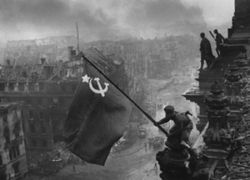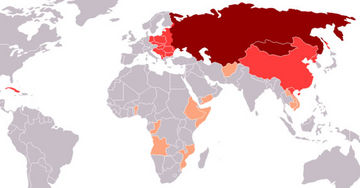Russia and the three ...isms
 In June 1933, William Branham experienced a series of 7 prophetic visions. In the third vision, Fascism and Nazism were swallowed up into Communism. A voice in the vision instructed William Branham to "watch Russia" (rather than "watch the U.S.S.R.") indicating the eventual fall of the Soviet Union and the formation of Russia into a distinct State. This vision has been completely fulfilled.
1955 and 1964 retelling of the 1933 prophecy<playmp3>Faith Once Delivered To The Saints, 1955|three isms 55-0501.mp3</playmp3>
See the sermon Faith Once Delivered To The Saints, 1955 for the full text of this prophecy.
Taken from Chapter 9 of the Church Ages Book (the Laodicean Church Age), William Branham
DefinitionsFascism is an authoritarian ideology that considers individual and other societal interests inferior to the needs of the state. The term Fascism was invented by Mussolini, who was the dictator of Italy before and during WWII. Fasces, which consisted of a bundle of rods tied around an axe, was an ancient Roman symbol of the authority of the civic magistrates, and symbolized strength through unity. Nazism was not a precise, theoretical ideology, but a combination of various ideologies and groups centered around anger at the Treaty of Versailles and what was considered to have been a Jewish/Communist conspiracy to humiliate Germany at the end of the First World War. Nazism consisted of a loose collection of incoherent positions focused on those held to blame for Germany's "weakness": anti-parliamentarism, ethnic nationalism, racism, collectivism, eugenics, anti-Semitism, opposition to economic and political liberalism, a racially-defined and conspiratorial view of finance capitalism, and anti-communism. As Nazism became dominant in Germany, it was defined in practice as whatever was decreed by the Nazi Party and in particular by the Führer, Adolf Hitler. Communism is an ideology that seeks to establish a classless, stateless social organization based on common ownership of the means of production. Communist ideals were first penned by Karl Marx, and instituted by Vlademir Lenin and the Bolsheviks after the Russian Revolution of 1917. By 1956, the U.S.S.R. had grown from a union of four Soviet Socialist Republics to a union of 15 republics. After Joseph Lenin (d. 1924) the U.S.S.R was been ruled by Joseph Stalin (d. 1953), Nikita Khrushchev (deposed in 1964), and a collective government from 1964 until Leonid Brezhnev (d. 1982) came to power in the 1970s. In the mid 1980s, the reform-minded Mikhail Gorbachev introducing the landmark policies of glasnost (openness) and perestroika (restructuring) in an attempt to modernize Soviet communism. His initiatives provoked strong resentment among some conservative elements of the government. The Fall of Nazism and Fascism, and the emergence of Russia ██ 1920s and 1930s ██ 1940s and 1950s ██ 1960s and 1970s The Fall of Fascism: In July 1943, the Italian King Vittorio Emanuele III and a group of Fascist leaders staged a coup d'etat against Mussolini, having him arrested. In September 1943 Italy surrendered to the Allies, but was immediately invaded by Germany. For nearly two years the country was divided and became a battlefield, with a puppet fascist state under Mussolini being reconstituted in the Nazi-occupied part of the country. On April 28, 1945, Mussolini was executed by Italian communist partisans. The Fall of Nazism: While the German army had initially had great success against the U.S.S.R, the tide turned at the Battle of Stalingrad (August 21, 1942 to February 2, 1943) during which almost 2 million Axis and Soviet soldiers were killed. The German army retreated on the Eastern Front until May 8, 1945 when the Red Army occupied Berlin, and Germany surrendered. Russia emerges from Communist U.S.S.R.: In August of 1991 an unsuccessful military coup attempted to remove Mikhail Gorbachev from power, but instead led to the collapse of the Soviet Union. Boris Yeltsin came to power and declared the end of exclusive Communist rule. The USSR splintered into fifteen independent republics, including Russia, and was officially dissolved in December of 1991. |
| Roosevelt |
| Mussolini |
| Hitler |
| 3 Isms |
| Driverless Cars |
| Morality |
| America |
| Ashes |







